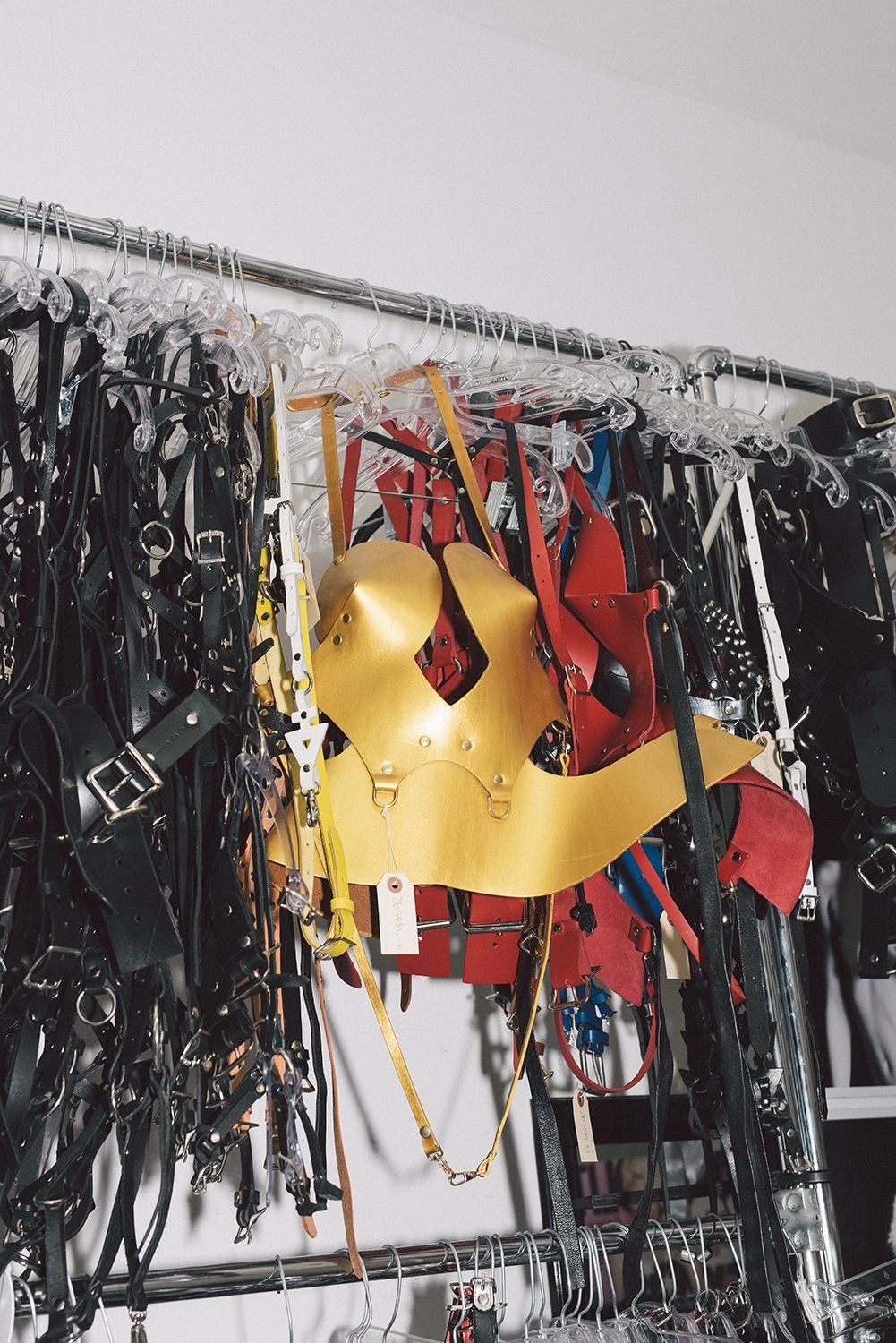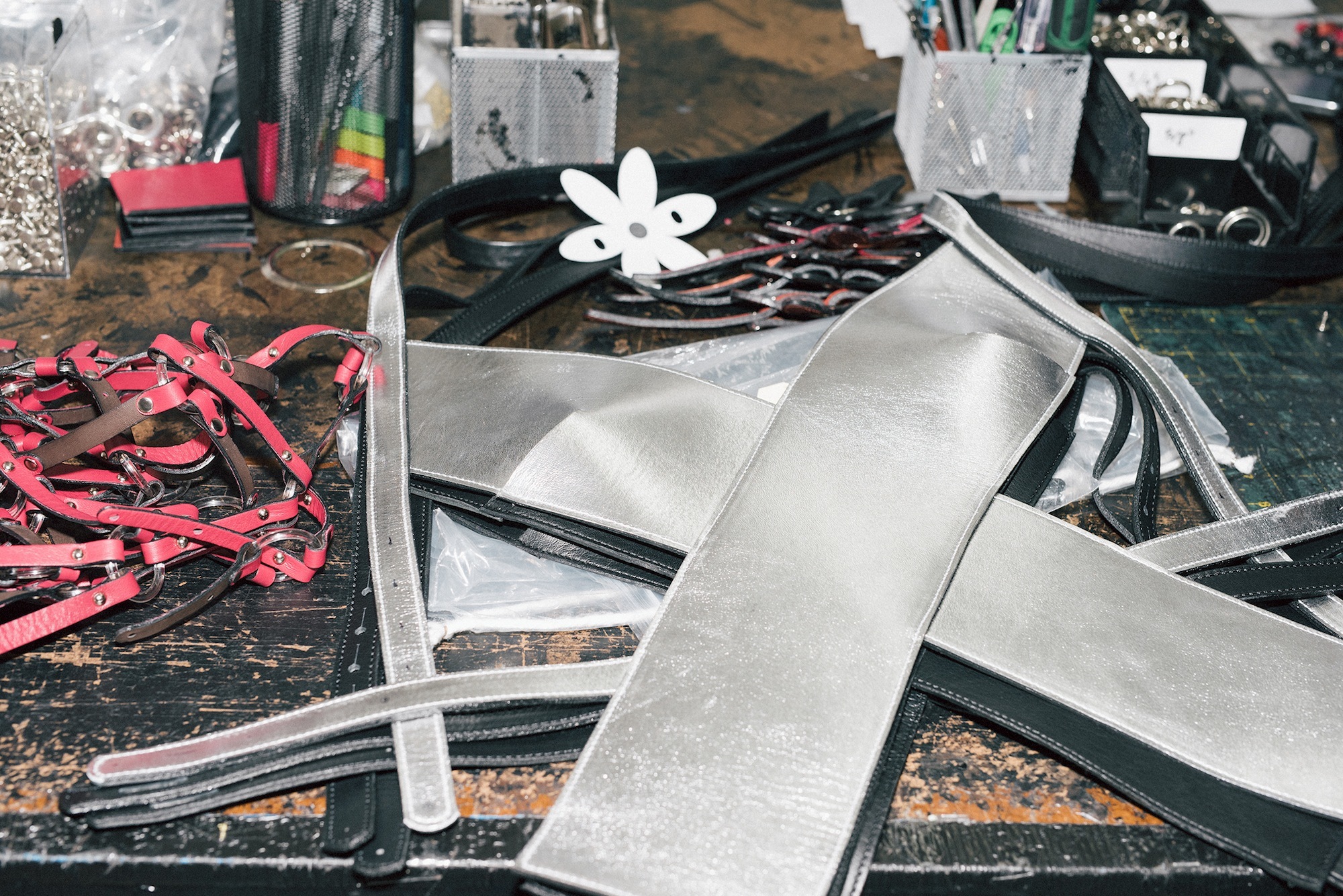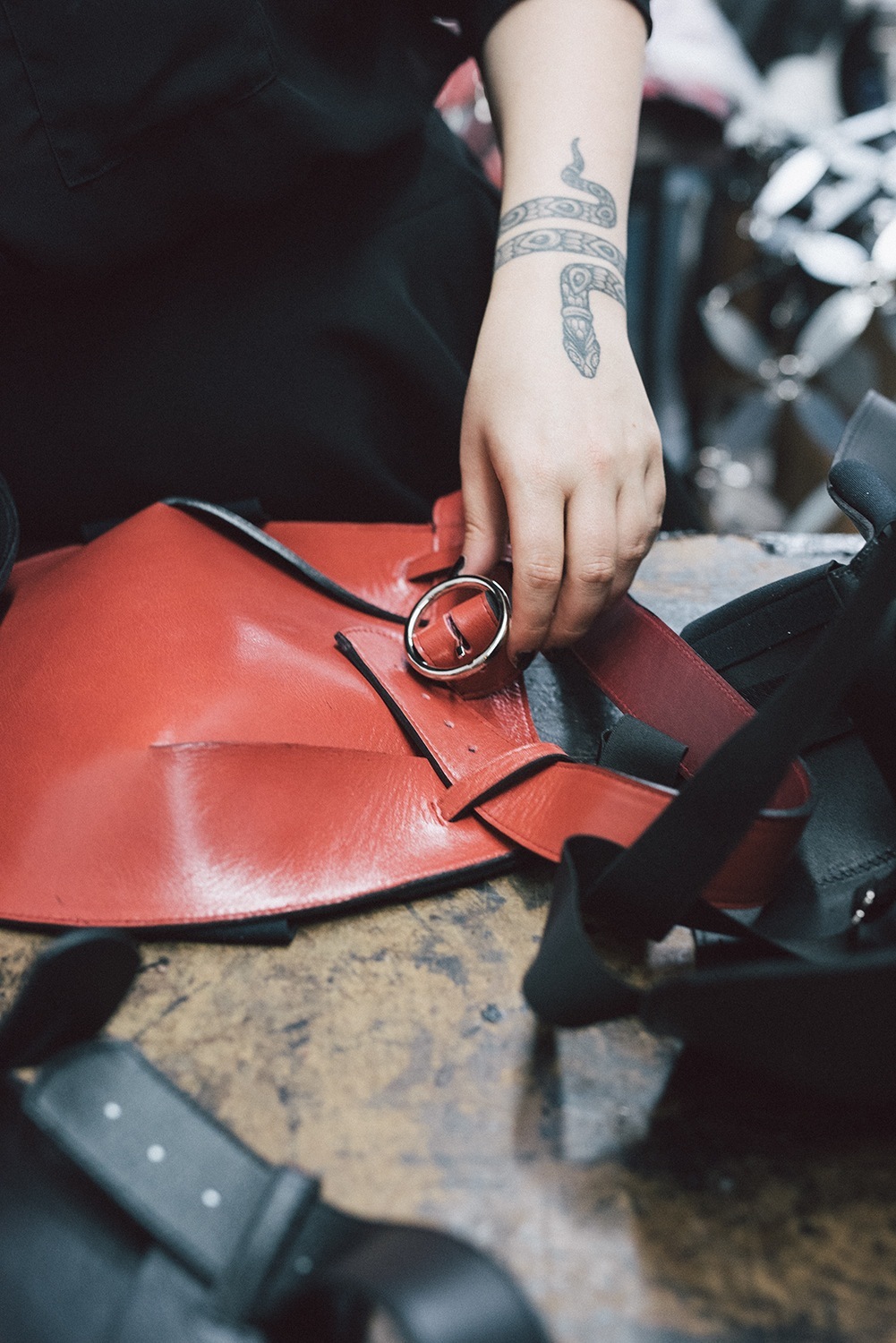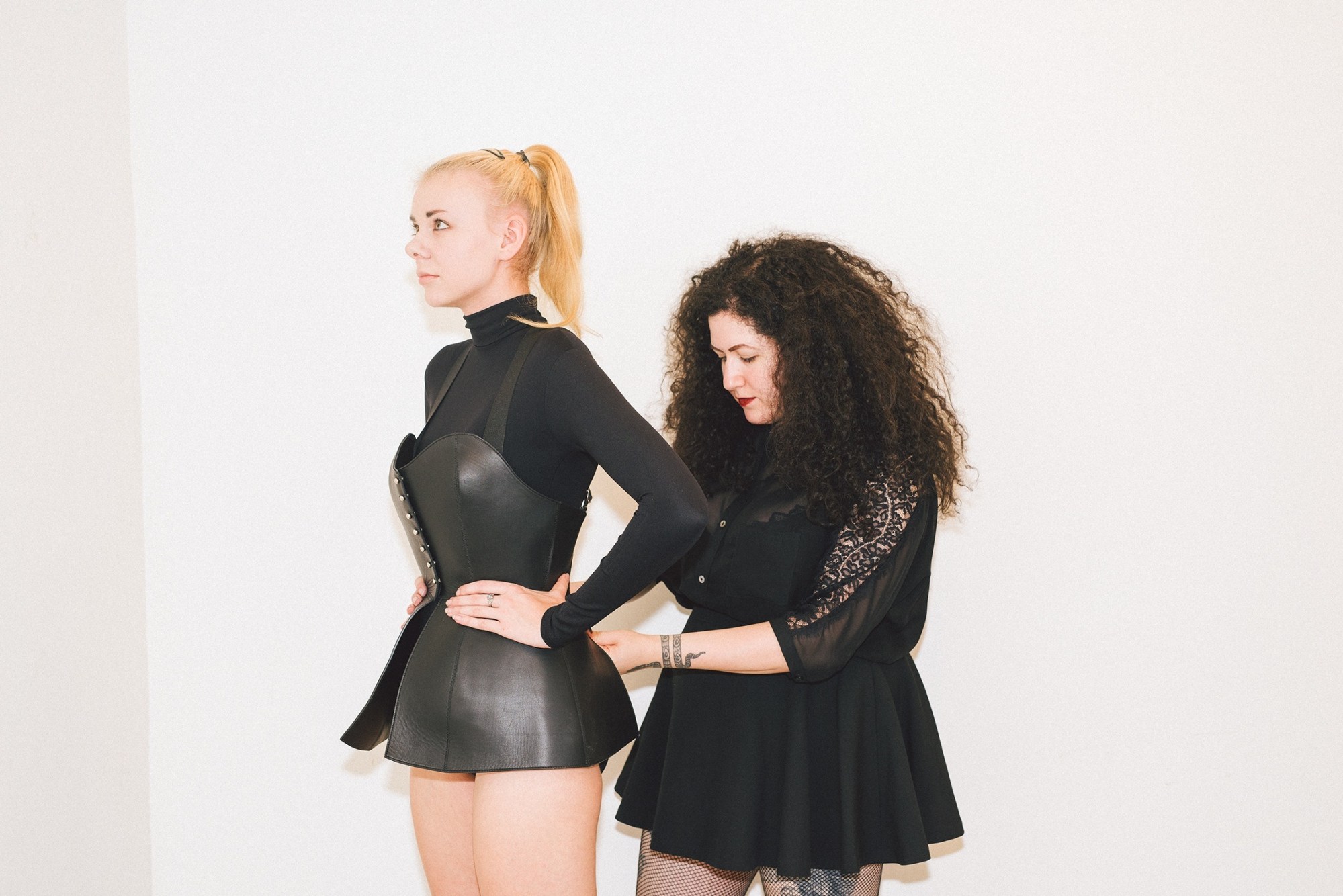You can smell Zana Bayne’s designs before you see them. On the tenth floor of a Garment District building, their aroma is subtle but distinctive: warm, creamy, slightly bitter, like coffee. The source is obvious the second you walk through the door. Straps and loops and rolls of leather cover every inch of surface area, forming spider-like webs. They beg you to get tangled up in them, like the photo on the wall of a model whose body is girdled by leather straps, her wrists tied with rope.
Bayne can’t actually smell leather anymore. Somewhere in between collecting dozens of 1970s belts in art school and creating custom harnesses for Madonna, Beyoncé, and Debbie Harry, the material (and its odor) became nearly as omnipresent as air. Even so, the thing Bayne loves about leather is that it’s impossible for other people to ignore. From punk and goth subcultures to designers like Gaultier and Westwood to San Francisco fetish clubs, the material “has a connection to the history of dressing up,” she says.

Everybody likes to dress up sometimes, and the secret to Zana Bayne’s success is knowing it. Her collection of leather accessories—chokers, cuffs, belts, harnesses, bustiers, bralets, face masks—sells to librarians and stylists and club kids and dominatrixes and everyone in between. “Leather is always going to have a [bondage] connotation,” she tells me. “But I’m finding different ways to play with it.”
Her spring/summer 2016 collection, for instance, which debuts today at New York Fashion Week, is more cabana in Miami Beach than leather bar. It’s full of peach and rose hues, belts shaped like flower petals, bamboo rings, custom-made buckles, and scallop trim. Called Bossa Nova, it references 60s Courrèges and Cardin.
The first harness that Zana Bayne designed was in 2009, when she was mostly known as a fashion blogger with a penchant for Margiela, DIY, and vintage. Living in San Francisco and going to art school, Bayne frequently made outfits for her and her friends to wear to the noise shows, drag shows, and fashion parties they frequented. When she posted the photo of herself wearing a harness on her blog—a simple, three-strapped version, still available on her site—readers wanted to buy one. A couple months later, when she moved to New York, Bayne decided to make harnesses for extra money. “I never thought it would turn into a line.” It did, though, and Bayne’s break came around 2011, when Nicola Formichetti commissioned custom, full-body harnesses for Lady Gaga and 10 dancers to wear in her video Yoü and I.

Bayne’s lack of official fashion training led to singular techniques. Her Rita bustier, for instance, a skin-tight leather top with adjustable straps in the back, features not a single stitch: just leather and 430 individual metal rivets. A lattice dress made of dozens of individual leather cutouts, fastened together with lightweight, plastic rings, is expandable, able to fit a size 2 or a 12. Gwen Stefani wore a similar one on the March cover of Cosmopolitan this year.
Being self-taught also contributes to her mythology as a designer. James Teague, her current studio director, recalls discovering her blog, Garbage Dress, while he was in high school in South Carolina. “She’s always been so unabashed.” After following her for years online, Teague moved to New York with the intention of working at her studio. He got an internship a few months later. “It blows my mind, but people still come up to me and say reading my blog is what inspired them to move to New York,” said Bayne. (The blog is now private, for the benefit of friends wanting to keep old party pics off their Google search results.)
A lot has changed in the six years since Bayne, now 27, made her first harness. Many of her contemporaries from the Gaga era, like Nicola Formichetti, went from being indie fashion darlings to global brands. Bayne has, too: she sells everywhere from Selfridges to Lane Crawford to Nasty Gal. She has a menswear and handbag line, and works in python and lambskin in addition to cowhide leather. Still, half of her business comes from the “Originals” collection, of simple black leather accessories designed in her early years. On a given day, while in the midst of creating a custom leather cap for a Patti Wilson special project, for instance, she also might get a request to repair a harness purchased by an OG customer years ago on her Etsy store. (Thorny requests are part of the game, for instance, a woman looking for a harness to wear during and after her pregnancy. Bayne pulled it off with some adjustable straps.)

Custom or otherwise, every piece passes through the studio and the hands of Bayne’s team, an army of happy fashion goths, who, like her, dress almost exclusively in black. Transforming stiff animal hide into shapes that effortlessly mold to the body requires high levels of technical knowledge about leather and its tools, as well as attention to quality. To make the scallop-trimmed belts in the spring/summer 2016 collection, for instance, Bayne commissioned a die, essentially a “cookie cutter” for leather made of wood and steel blades that punch precise shapes. A decades-old factory around the corner implements it, pressing the die into the leather with a giant hydraulic press. Other leather pieces are cut by hand in Bayne’s studio, where the finishing touches—dying edges, attaching buckles, branding logos—also happen. “I love having production in New York, especially because so many factories in this neighborhood are getting displaced,” she notes. Every day, Bayne’s team makes runs to its factories, as well as to the trade shops around the district, coming back with armfuls of buckles, rivets, tools, leather samples, and, in the days leading up to Fashion Week, coffee. (“I’m nothing like my drink,” the black-haired Bayne jokes after ordering a Skinny Iced Caramel Macchiato).
Ultimately, Zana Bayne’s goal is to grow without abandoning her roots. In the years ahead, she hopes to create new types of leather accessories, like shoes, and open one or two Zana Bayne stores in her favorite cities, all while continuing to spend days working with leather in her studio. Selling out isn’t much of a concern. When I ask Bayne how she feels about the pop-ification of BDSM, with 50 Shades of Grey and innumerable top 40 songs, she surprises me with her answer: “I don’t think it’s bad that it’s getting exposure in the mainstream, as long as it’s inspiring people to learn something new or open their minds. It’s about the quality of how it’s done.”
Read more i-D fashion month coverage here

Credits
Text Alice Hines
Photography Katie McCurdy
